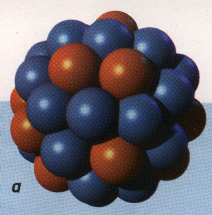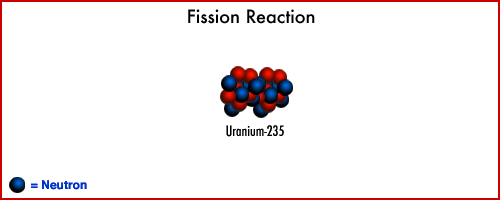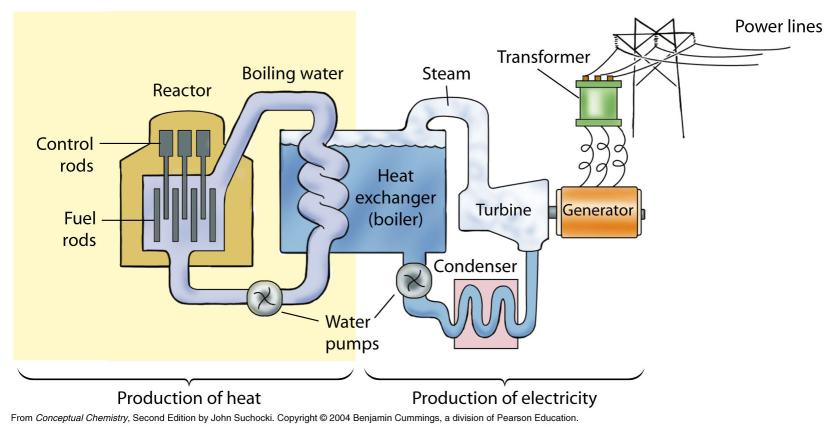 Nuclear
fission and a brave new world
Nuclear
fission and a brave new world Nuclear
fission and a brave new world
Nuclear
fission and a brave new world
question | argument | sources | lesson
![]()
Can nuclear fission be used to produce electricity while reducing the amount of a nation's carbon dioxide emissions?
Well, on the surface yes, but do we need to look below the obvious comparison of a coal burning electrical plant that produces a great mass of carbon dioxide per ton of fuel and fissionable uranium which technically produces no carbon emissions?
a: graphical drawing depicting the neutrons & protons in an atomic nuclei.

Argument:
Pro nuclear information
has been widespread and on since the Kyoto Protocol as an alleged way to reduce
carbon dioxide emissions from the generation of electricity.
• I have never heard anyone speak publicly about how much electricity it takes to refine uranium into fissionable material, let alone enough reactor grade fuel --(it takes a lot of serious work and electrical energy to refine uranium ore).
And where does that electricity come from?
There is a second problem that is little reported concerning waste. Nuclear
waste (fissionable uranium or plutonium  once
used is called spent fuel and the rods are encased in steel and concrete and
stored at nuclear power plants.) Soon the material will be trucked to a central
depository. Central in the sense of one place, since geographically the site
selected for burying nuclear spent fuel is in the extreme west, Nevada.
once
used is called spent fuel and the rods are encased in steel and concrete and
stored at nuclear power plants.) Soon the material will be trucked to a central
depository. Central in the sense of one place, since geographically the site
selected for burying nuclear spent fuel is in the extreme west, Nevada.
But there is a scandal brewing over the depository and its impact ion the surrounding area, near Las Vegas, Nevada. This is a place called Yucca Maintain. There have been serious questions raised and the USGS falsification of groundwater data is alleged to have covered up serious problems with the underground storage of all the nation's spent reactor fuel.
Union
of Concerned Scientists has a web site that is pretty anti nuke.
Fabric ground information, called a back grounder, my site: the puzzle of plutonium, may get you started, but do not stop there.
The basic information exists that refining uranium into plutonium for use in reactors takes time, money and ample electricity. The United States initially did so from 1942 until 1945 and we used hydroelectricity provided by the TVA or Tennessee Valley Authority and the Columbia River dams to produce even more costly weapons grade, fissionable material at Huntsville, Alabama and Hanford, Washington.
Either Wired Magazine or Technology
Review (MIT) has done a great pro nuke article of late saying how safety
and smaller sizes are a better way to go -- no real focus on spent fuel, or
hot water (thermal water) discharges, however.
An
old exposé by two journalists is called Forevermore:
Nuclear Waste in America
[1985; W.W. Norton & Company]. It is written by two reporters and they say:
"Radioactive nuclear waste is the deadliest substance on earth. It is invisible: you can neither smell nor taste it, and one curie of it will kill. No one knows how much there is, or even where all of it is stored. But every year there is more and more, and no one knows what to do with it.
This is but one conclusion drawn in this superbly researched, compelling account of the forty-year failure to grapple with the deadly radioactive waste that burgeons out around us.
In 1985 the government must choose a site for high-level waste storage and, shortly after, a number of low-level dumps. Since no state wants these dumps, politicians are playing a game of radioactive musical chairs, each seeking to exempt their constituents from waste sites, through special deals struck in Washington.
Even so, no state is totally free from danger."
Barlett and Steele who wrote this really good book about what killed nuclear power are award winning researchers. They document that (not Q -- Three Mile Island, or Chernobyl) finances and management have hindered the development of nuclear fission as a form of energy for electricity and not antinuclear activists, who have neither the money nor the influence to seriously affect government policies with respect to energy.
When considering nuclear fission as a source of electricity always recall three things:
1. basically nobody wants to invest in them in a deregulated energy market (semi-deregulated) when the return on wind power installations is within a year, and when oil has a huge depletion allowance.
2. nobody knows what to do with the waste, which is now stored on site at Indian Point, or Pilgrim, etc.
3. the French are the folks to look closely at as a model since almost 7 out of every 10 electrons is generated by fission plants all around France.
One way to think about a nuclear plant is that they represent the ultimate defense against invasion by a non nuclear power -- the material can go critical destroying the occupying force in a sort of macabre Phyrric victory (an ultimate defeat despite the initial conquest because of the long term consequences or cost in terms of losses to endure the initial vanquishing of the enemy only to eventually incur a humiliating sort of pay-back) -- that is probably why the Arabs have not invaded Israel since the early 1970s.
Question | argument | sources | return to start
This button below works as a navigational aid.
schedule | Research home | Atlas | site-map | Ecology | laws | reliable web sites | quick look
Science Index | Site Analysis | Population Index | Global Warming Index | Nature Index | Research sites | Genes
Terms | Glossary | Word webs | Basic vocabulary | Advanced Vocabulary | Antonyms | Synonyms | Etymology | Concepts
Writing | Interviews | Free Writing